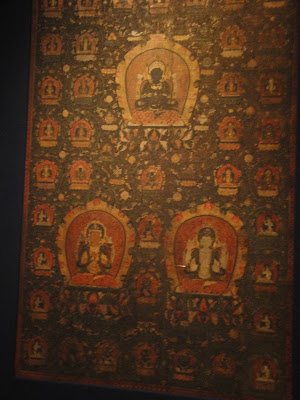I love New York's Metropolitan Museum of Art! There is so much to see, and we saw just about everything. In this post, I'll focus on three areas. The Fashion, Asian, and American art exhibits.
 |
| I imagine this elegant dress worn by a woman hostessing a grand party in her fashionable new American mansion |
In Pursuit of Fashion: The Sandy Shreier Collection is on view at New York's Metropolitan Museum of Art through May 17, 2020. An American collector, Schreier at first collected fashion for its beauty. Later, she came to appreciate the way fashion can tell the story of an era. She wanted to recognize and preserve the creativity of the designers and skill of the workers in the fashion industry.
 |
| Early 20th century - Fortuny and Galenga fashions - intentionally antique-looking, yet comfortable and made with luxurious fabrics |
 |
| 1910-1930's - An evening out in a simple, comfortable dress decorated to be seen and have a wildly fun night out dancing til dawn! |
 |
| 1930's-1950's Hollywood's Golden Era inspired glamour |
 |
| Remember Twiggy in the 1960's? Don't bend over! |
 |
| Fashion and art combine for the perfect conversation starter |
After the fashion exhibit, we headed over to the Asian wing where we saw a garden, Luohans, tangkas, and Buddhas.
Luohans are the original followers of Buddha. They have followed the eight-fold path and have attained the four stages of enlightenment. Their main purpose is to protect the Buddhist faith and wait for the future Buddha to arrive on Earth.
Tibetan Tangka are paintings on cotton or silk that can be rolled up for storage when not being displayed. They may display a Buddha or mandala.
 |
| Asian Landscape |
 |
| Japanese screen |
At first the deer, pictured below, may seem out of place, but this taxidermied deer covered in glass beads is reminiscent of 13th and 14th century religious paintings known as Kasuga Deer Mandala. The deer is a messenger of Shinto deities.
 |
| Buddha |
Last, we finished our trip with a visit to the American wing.
 |
| I didn't catch the title or artist of this painting, but was drawn to the sunshine yellow bonnet |
In contrast to the fashion exhibit, this woman wears a functional outfit that keeps her warm in the cool overcast weather along the shore. I love the way her skirt blends into the landscape, while the bonnet frames the focal point, which is her face. The same yellow used in the bonnet is also in the skyline along the horizon. Notice how the use of yellow and white in the skyline, scarf, cuffs, and bonnet ties lead your eye up to her face, which is helped to standout against a subtly blue sky on the top third of the painting.
 |
| Quiet neutral color contrasts with the painting above |
His hair slightly disheveled, as though he has just stepped inside, the portrait of this man against a plain, dark interior wall drew me in for the exact opposite reason of the yellow bonnet. In this case, it was the use of neutrals on both figure and background that caught my eye. His curly hair, almost the color of his waistcoat, blends into the background. Instead of a frame around his face, we are directed to his face by both the white, tight wrapping neck scarf which serves to underline his jaw and chin; and his almost full faced gaze at us. The only use of bright color is reserved for the man's skin tones in pinks, as well as a bit of red on the lips and ears, which brings him to life against the otherwise drab neutrals.
I was pleased to see the American wing was not limited to European immigrants. These portraits of Native Americans demonstrate a respect for people and civilizations in existence long before Europeans sought a new land. Pes-Ke-Le-Cha-Co, chief of the Pawnees, wears a silver peace medal and a red head dress. Pictured below, the portrait of a Native American woman, wife of Chief of the Otoe-Missouria people—emphasizes her distinctive beauty and bearing.
Always a delight for me, Hudson River School paintings! In general, any people or animals are just small dots on a grand landscape of natural beauty. This proportion seems both right and relevant in an era when the evidence of human pollution is everywhere. How I wish I could step back in time, and in to these scenes (keeping myself very small).
A few famous and historical paintings: Washington Crossing the Delaware, and The Last Moments of John Brown.
Above, take a close look at the boats in the background. You'll see not just more soldiers, but horses and supplies. Below, notice the triangular arrangement of the figures, a device used by artists to provide strength and power to the story or message of the painting. Take a look at the angle of the guns, creating a tension that almost pushes down Brown's bent head as he leans over to kiss a baby. The patches of red in the painting lead up the left side of the triangle and down on the right, just as Brown walks down the steps on his way to to be hung. Sadly, 160 years later, we still have too much racial division in this country.
Finally, we'll finish our tour of the American Gallery paintings with a few domestic scenes we can all relate to: story time, chores, and a spot of tea.
This finishes my five-part series featuring my trip to New York City. Next week, we're off to the Mystic Seaport in Connecticut for a community sing-a-long!
See books by Laura S. Pringle on Amazon
The Pringle Plan is a series of educational guides.
©2019 Laura S. Pringle. All Rights Reserved.





























No comments:
Post a Comment
Share your comments.